学习https://matplotlib.org/gallery/index.html 记录,描述不一定准确,具体请参考官网
Matplotlib使用总结图
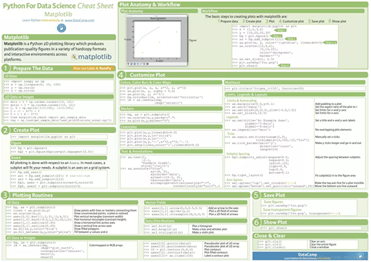
- import matplotlib.pyplot as plt
- plt.rcParams['font.sans-serif']=['SimHei'] # 用来正常显示中文标签
- plt.rcParams['axes.unicode_minus']=False # 用来正常显示负号
- import pandas as pd
- import numpy as np
新建隐藏坐标轴
- from mpl_toolkits.axisartist.axislines import SubplotZero
- import numpy as np
- fig = plt.figure(1, (10, 6))
- ax = SubplotZero(fig, 1, 1, 1)
- fig.add_subplot(ax)
- """新建坐标轴"""
- ax.axis["xzero"].set_visible(True)
- ax.axis["xzero"].label.set_text("新建y=0坐标")
- ax.axis["xzero"].label.set_color('green')
- # ax.axis['yzero'].set_visible(True)
- # ax.axis["yzero"].label.set_text("新建x=0坐标")
- # 新建一条y=2横坐标轴
- ax.axis["新建1"] = ax.new_floating_axis(nth_coord=0, value=2,axis_direction="bottom")
- ax.axis["新建1"].toggle(all=True)
- ax.axis["新建1"].label.set_text("y = 2横坐标")
- ax.axis["新建1"].label.set_color('blue')
- """坐标箭头"""
- ax.axis["xzero"].set_axisline_style("-|>")
- """隐藏坐标轴"""
- # 方法一:隐藏上边及右边
- # ax.axis["right"].set_visible(False)
- # ax.axis["top"].set_visible(False)
- #方法二:可以一起写
- ax.axis["top",'right'].set_visible(False)
- # 方法三:利用 for in
- # for n in ["bottom", "top", "right"]:
- # ax.axis[n].set_visible(False)
- """设置刻度"""
- ax.set_ylim(-3, 3)
- ax.set_yticks([-1,-0.5,0,0.5,1])
- ax.set_xlim([-5, 8])
- # ax.set_xticks([-5,5,1])
- #设置网格样式
- ax.grid(True, linestyle='-.')
- xx = np.arange(-4, 2*np.pi, 0.01)
- ax.plot(xx, np.sin(xx))
- # 于 offset 处新建一条纵坐标
- offset = (40, 0)
- new_axisline = ax.get_grid_helper().new_fixed_axis
- ax.axis["新建2"] = new_axisline(loc="right", offset=offset, axes=ax)
- ax.axis["新建2"].label.set_text("新建纵坐标")
- ax.axis["新建2"].label.set_color('red')
- plt.show()
- # 存为图像
- # fig.savefig('test.png')
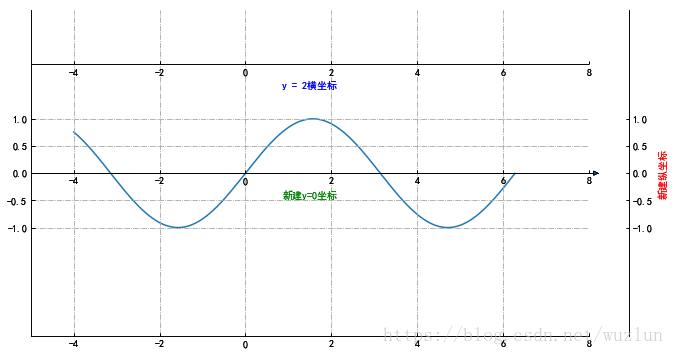
- from mpl_toolkits.axes_grid1 import host_subplot
- import mpl_toolkits.axisartist as AA
- import matplotlib.pyplot as plt
- host = host_subplot(111, axes_class=AA.Axes)
- plt.subplots_adjust(right=0.75)
- par1 = host.twinx()
- par2 = host.twinx()
- offset = 100
- new_fixed_axis = par2.get_grid_helper().new_fixed_axis
- par2.axis["right"] = new_fixed_axis(loc="right",
- axes=par2,
- offset=(offset, 0))
- par1.axis["right"].toggle(all=True)
- par2.axis["right"].toggle(all=True)
- host.set_xlim(0, 2)
- host.set_ylim(0, 2)
- host.set_xlabel("Distance")
- host.set_ylabel("Density")
- par1.set_ylabel("Temperature")
- par2.set_ylabel("Velocity")
- p1, = host.plot([0, 1, 2], [0, 1, 2], label="Density")
- p2, = par1.plot([0, 1, 2], [0, 3, 2], label="Temperature")
- p3, = par2.plot([0, 1, 2], [50, 30, 15], label="Velocity")
- par1.set_ylim(0, 4)
- par2.set_ylim(1, 65)
- host.legend()
- host.axis["left"].label.set_color(p1.get_color())
- par1.axis["right"].label.set_color(p2.get_color())
- par2.axis["right"].label.set_color(p3.get_color())
- plt.draw()
- plt.show()

- # 第二坐标
- fig, ax_f = plt.subplots()
- # 这步是关键
- ax_c = ax_f.twinx()
- ax_d = ax_f.twiny()
- # automatically update ylim of ax2 when ylim of ax1 changes.
- # ax_f.callbacks.connect("ylim_changed", convert_ax_c_to_celsius)
- ax_f.plot(np.linspace(-40, 120, 100))
- ax_f.set_xlim(0, 100)
- # ax_f.set_title('第二坐标', size=14)
- ax_f.set_ylabel('Y轴',color='r')
- ax_f.set_xlabel('X轴',color='c')
- ax_c.set_ylabel('第二Y轴', color='b')
- ax_c.set_yticklabels(["$0$", r"$\frac{1}{2}\pi$", r"$\pi$", r"$\frac{3}{2}\pi$", r"$2\pi$"])
- # ax_c.set_ylim(1,5)
- ax_d.set_xlabel('第二X轴', color='g')
- ax_d.set_xlim(-1,1)
- plt.show()
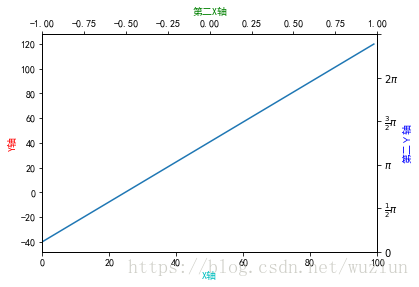
刻度及标记
- import mpl_toolkits.axisartist.axislines as axislines
- fig = plt.figure(1, figsize=(10, 6))
- fig.subplots_adjust(bottom=0.2)
- # 子图1
- ax1 = axislines.Subplot(fig, 131)
- fig.add_subplot(ax1)
- # for axis in ax.axis.values():
- # axis.major_ticks.set_tick_out(True) # 标签全部在外部
- ax1.axis[:].major_ticks.set_tick_out(True) # 这句和上面的for循环功能相同
- ax1.axis["left"].label.set_text("子图1 left标签") # 显示在左边
- # 设置刻度
- ax1.set_yticks([2,4,6,8])
- ax1.set_xticks([0.2,0.4,0.6,0.8])
- # 子图2
- ax2 = axislines.Subplot(fig, 132)
- fig.add_subplot(ax2)
- ax2.set_yticks([1,3,5,7])
- ax2.set_yticklabels(('one','two','three', 'four', 'five')) # 不显示‘five'
- ax2.set_xlim(5, 0) # X轴刻度
- ax2.axis["left"].set_axis_direction("right")
- ax2.axis["left"].label.set_text("子图2 left标签") # 显示在右边
- ax2.axis["bottom"].set_axis_direction("top")
- ax2.axis["right"].set_axis_direction("left")
- ax2.axis["top"].set_axis_direction("bottom")
- # 子图3
- ax3 = axislines.Subplot(fig, 133)
- fig.add_subplot(ax3)
- # 前两位表示X轴范围,后两位表示Y轴范围
- ax3.axis([40, 160, 0, 0.03])
- ax3.axis["left"].set_axis_direction("right")
- ax3.axis[:].major_ticks.set_tick_out(True)
- ax3.axis["left"].label.set_text("Long Label Left")
- ax3.axis["bottom"].label.set_text("Label Bottom")
- ax3.axis["right"].label.set_text("Long Label Right")
- ax3.axis["right"].label.set_visible(True)
- ax3.axis["left"].label.set_pad(0)
- ax3.axis["bottom"].label.set_pad(20)
- plt.show()
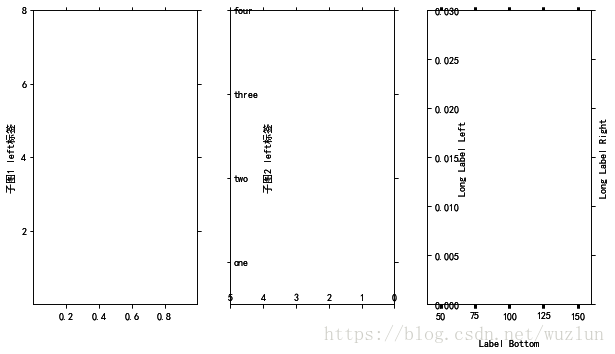
- import matplotlib.ticker as ticker
- # Fixing random state for reproducibility
- np.random.seed(19680801)
- fig, ax = plt.subplots()
- ax.plot(100*np.random.rand(20))
- # 设置 y坐标轴刻度
- formatter = ticker.FormatStrFormatter('$%1.2f')
- ax.yaxis.set_major_formatter(formatter)
- # 刻度
- for tick in ax.yaxis.get_major_ticks():
- tick.label1On = True # label1On 左边纵坐标
- tick.label2On = True # label2On 右边纵坐标
- tick.label1.set_color('red')
- tick.label2.set_color('green')
- # 刻度线
- for line in ax.yaxis.get_ticklines():
- # line is a Line2D instance
- line.set_color('green')
- line.set_markersize(25)
- line.set_markeredgewidth(3)
- # 刻度 文字
- for label in ax.xaxis.get_ticklabels():
- # label is a Text instance
- label.set_color('red')
- label.set_rotation(45)
- label.set_fontsize(16)
- plt.show()
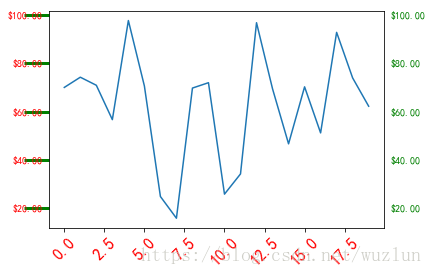
- import mpl_toolkits.axisartist as axisartist
- def setup_axes(fig, rect):
- ax = axisartist.Subplot(fig, rect)
- fig.add_subplot(ax)
- ax.set_yticks([0.2, 0.8])
- # 设置刻度标记
- ax.set_yticklabels(["short", "loooong"])
- ax.set_xticks([0.2, 0.8])
- ax.set_xticklabels([r"$\frac{1}{2}\pi$", r"$\pi$"])
- return ax
- fig = plt.figure(1, figsize=(3, 5))
- fig.subplots_adjust(left=0.5, hspace=0.7)
- ax = setup_axes(fig, 311)
- ax.set_ylabel("ha=right")
- ax.set_xlabel("va=baseline")
- ax = setup_axes(fig, 312)
- # 刻度标签对齐方式
- ax.axis["left"].major_ticklabels.set_ha("center") # 居中
- ax.axis["bottom"].major_ticklabels.set_va("top") # 项部
- ax.set_ylabel("ha=center")
- ax.set_xlabel("va=top")
- ax = setup_axes(fig, 313)
- ax.axis["left"].major_ticklabels.set_ha("left") # 左边
- ax.axis["bottom"].major_ticklabels.set_va("bottom") # 底部
- ax.set_ylabel("ha=left")
- ax.set_xlabel("va=bottom")
- plt.show()
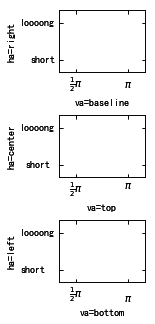
共享坐标轴
- # 共享坐标轴 方法一
- t = np.arange(0.01, 5.0, 0.01)
- s1 = np.sin(2 * np.pi * t)
- s2 = np.exp(-t)
- s3 = np.sin(4 * np.pi * t)
- plt.subplots_adjust(top=2) #位置调整
- ax1 = plt.subplot(311)
- plt.plot(t, s1)
- plt.setp(ax1.get_xticklabels(), fontsize=6)
- plt.title('我是原坐标')
- # 只共享X轴 sharex
- ax2 = plt.subplot(312, sharex=ax1)
- plt.plot(t, s2)
- # make these tick labels invisible
- plt.setp(ax2.get_xticklabels(), visible=False)
- plt.title('我共享了X轴')
- # 共享X轴和Y轴 sharex、sharey
- ax3 = plt.subplot(313, sharex=ax1, sharey=ax1)
- plt.plot(t, s3)
- plt.xlim(0.01, 5.0) #不起作用
- plt.title('我共享了X轴和Y轴')
- plt.show()

- # 共享坐标轴 方法二
- x = np.linspace(0, 2 * np.pi, 400)
- y = np.sin(x ** 2)
- f, axarr = plt.subplots(2, sharex=True)
- f.suptitle('共享X轴')
- axarr[0].plot(x, y)
- axarr[1].scatter(x, y, color='r')
- f, (ax1, ax2) = plt.subplots(1, 2, sharey=True)
- f.suptitle('共享Y轴')
- ax1.plot(x, y)
- ax2.scatter(x, y)
- f, axarr = plt.subplots(3, sharex=True, sharey=True)
- f.suptitle('同时共享X轴和Y轴')
- axarr[0].plot(x, y)
- axarr[1].scatter(x, y)
- axarr[2].scatter(x, 2 * y ** 2 - 1, color='g')
- # 间距调整为0
- f.subplots_adjust(hspace=0)
- # 设置全部标签在外部
- for ax in axarr:
- ax.label_outer()
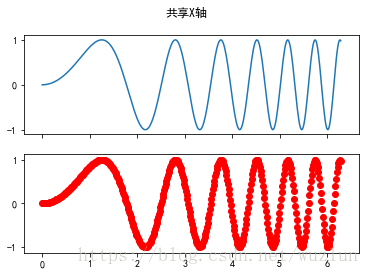
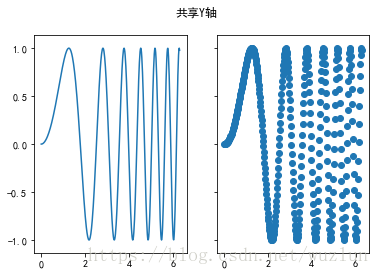
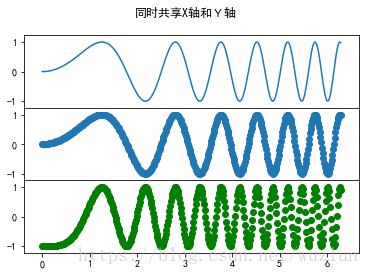
放大缩小
- def f(t):
- return np.exp(-t) * np.cos(2*np.pi*t)
- t1 = np.arange(0.0, 3.0, 0.01)
- ax1 = plt.subplot(212)
- ax1.margins(0.05) # Default margin is 0.05, value 0 means fit
- ax1.plot(t1, f(t1), 'k')
- ax2 = plt.subplot(221)
- ax2.margins(2, 2) # Values >0.0 zoom out
- ax2.plot(t1, f(t1), 'r')
- ax2.set_title('Zoomed out')
- ax3 = plt.subplot(222)
- ax3.margins(x=0, y=-0.25) # Values in (-0.5, 0.0) zooms in to center
- ax3.plot(t1, f(t1), 'g')
- ax3.set_title('Zoomed in')
- plt.show()
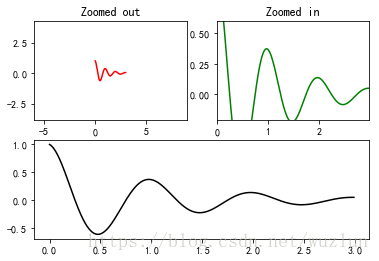
- from matplotlib.transforms import Bbox, TransformedBbox, \
- blended_transform_factory
- from mpl_toolkits.axes_grid1.inset_locator import BboxPatch, BboxConnector,\
- BboxConnectorPatch
- def connect_bbox(bbox1, bbox2,
- loc1a, loc2a, loc1b, loc2b,
- prop_lines, prop_patches=None):
- if prop_patches is None:
- prop_patches = prop_lines.copy()
- prop_patches["alpha"] = prop_patches.get("alpha", 1) * 0.2
- c1 = BboxConnector(bbox1, bbox2, loc1=loc1a, loc2=loc2a, **prop_lines)
- c1.set_clip_on(False)
- c2 = BboxConnector(bbox1, bbox2, loc1=loc1b, loc2=loc2b, **prop_lines)
- c2.set_clip_on(False)
- bbox_patch1 = BboxPatch(bbox1, **prop_patches)
- bbox_patch2 = BboxPatch(bbox2, **prop_patches)
- p = BboxConnectorPatch(bbox1, bbox2,
- # loc1a=3, loc2a=2, loc1b=4, loc2b=1,
- loc1a=loc1a, loc2a=loc2a, loc1b=loc1b, loc2b=loc2b,
- **prop_patches)
- p.set_clip_on(False)
- return c1, c2, bbox_patch1, bbox_patch2, p
- def zoom_effect01(ax1, ax2, xmin, xmax, **kwargs):
- """
- ax1 : the main axes
- ax1 : the zoomed axes
- (xmin,xmax) : the limits of the colored area in both plot axes.
- connect ax1 & ax2. The x-range of (xmin, xmax) in both axes will
- be marked. The keywords parameters will be used ti create
- patches.
- """
- trans1 = blended_transform_factory(ax1.transData, ax1.transAxes)
- trans2 = blended_transform_factory(ax2.transData, ax2.transAxes)
- bbox = Bbox.from_extents(xmin, 0, xmax, 1)
- mybbox1 = TransformedBbox(bbox, trans1)
- mybbox2 = TransformedBbox(bbox, trans2)
- prop_patches = kwargs.copy()
- prop_patches["ec"] = "none"
- prop_patches["alpha"] = 0.2
- c1, c2, bbox_patch1, bbox_patch2, p = \
- connect_bbox(mybbox1, mybbox2,
- loc1a=3, loc2a=2, loc1b=4, loc2b=1,
- prop_lines=kwargs, prop_patches=prop_patches)
- ax1.add_patch(bbox_patch1)
- ax2.add_patch(bbox_patch2)
- ax2.add_patch(c1)
- ax2.add_patch(c2)
- ax2.add_patch(p)
- return c1, c2, bbox_patch1, bbox_patch2, p
- def zoom_effect02(ax1, ax2, **kwargs):
- """
- ax1 : the main axes
- ax1 : the zoomed axes
- Similar to zoom_effect01. The xmin & xmax will be taken from the
- ax1.viewLim.
- """
- tt = ax1.transScale + (ax1.transLimits + ax2.transAxes)
- trans = blended_transform_factory(ax2.transData, tt)
- mybbox1 = ax1.bbox
- mybbox2 = TransformedBbox(ax1.viewLim, trans)
- prop_patches = kwargs.copy()
- prop_patches["ec"] = "none"
- prop_patches["alpha"] = 0.2
- c1, c2, bbox_patch1, bbox_patch2, p = \
- connect_bbox(mybbox1, mybbox2,
- loc1a=3, loc2a=2, loc1b=4, loc2b=1,
- prop_lines=kwargs, prop_patches=prop_patches)
- ax1.add_patch(bbox_patch1)
- ax2.add_patch(bbox_patch2)
- ax2.add_patch(c1)
- ax2.add_patch(c2)
- ax2.add_patch(p)
- return c1, c2, bbox_patch1, bbox_patch2, p
- import matplotlib.pyplot as plt
- plt.figure(1, figsize=(5, 5))
- ax1 = plt.subplot(221)
- ax2 = plt.subplot(212)
- ax2.set_xlim(0, 1)
- ax2.set_xlim(0, 5)
- zoom_effect01(ax1, ax2, 0.2, 0.8)
- ax1 = plt.subplot(222)
- ax1.set_xlim(2, 3)
- ax2.set_xlim(0, 5)
- zoom_effect02(ax1, ax2)
- plt.show()
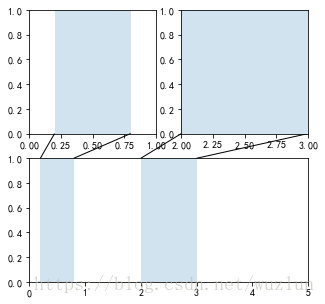
嵌入式标轴轴
- # 相同随机数
- np.random.seed(19680801)
- # create some data to use for the plot
- dt = 0.001
- t = np.arange(0.0, 10.0, dt)
- r = np.exp(-t[:1000] / 0.05) # impulse response
- x = np.random.randn(len(t))
- s = np.convolve(x, r)[:len(x)] * dt # colored noise
- # the main axes is subplot(111) by default
- plt.plot(t, s)
- #坐标轴
- plt.axis([0, 1, 1.1 * np.min(s), 2 * np.max(s)])
- plt.xlabel('time (s)')
- plt.ylabel('current (nA)')
- plt.title('Gaussian colored noise')
- # this is an inset axes over the main axes
- a = plt.axes([.65, .6, .2, .2], facecolor='k')
- n, bins, patches = plt.hist(s, 400, density=True, orientation='horizontal')
- plt.title('Probability')
- plt.xticks([])
- plt.yticks([])
- # # this is another inset axes over the main axes
- a = plt.axes([0.2, 0.6, .2, .2], facecolor='k')
- plt.plot(t[:len(r)], r)
- plt.title('Impulse response')
- plt.xlim(0, 0.2)
- plt.xticks([])
- plt.yticks([])
- plt.show()
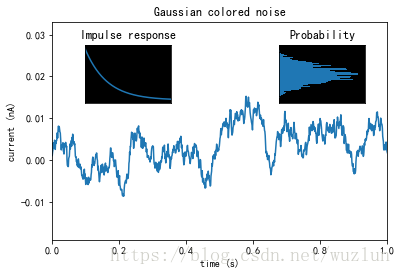
非常规坐标轴
- # 30 points between [0, 0.2) originally made using np.random.rand(30)*.2
- pts = np.array([
- 0.015, 0.166, 0.133, 0.159, 0.041, 0.024, 0.195, 0.039, 0.161, 0.018,
- 0.143, 0.056, 0.125, 0.096, 0.094, 0.051, 0.043, 0.021, 0.138, 0.075,
- 0.109, 0.195, 0.050, 0.074, 0.079, 0.155, 0.020, 0.010, 0.061, 0.008])
- # Now let's make two outlier points which are far away from everything.
- pts[[3, 14]] += .8
- # If we were to simply plot pts, we'd lose most of the interesting
- # details due to the outliers. So let's 'break' or 'cut-out' the y-axis
- # into two portions - use the top (ax) for the outliers, and the bottom
- # (ax2) for the details of the majority of our data
- f, (ax, ax2) = plt.subplots(2, 1, sharex=True)
- # plot the same data on both axes
- ax.plot(pts)
- ax2.plot(pts)
- # zoom-in / limit the view to different portions of the data
- ax.set_ylim(.78, 1.) # outliers only
- ax2.set_ylim(0, .22) # most of the data
- # hide the spines between ax and ax2
- ax.spines['bottom'].set_visible(False)
- ax2.spines['top'].set_visible(False)
- ax.xaxis.tick_top()
- ax.tick_params(labeltop=False) # don't put tick labels at the top
- ax2.xaxis.tick_bottom()
- # This looks pretty good, and was fairly painless, but you can get that
- # cut-out diagonal lines look with just a bit more work. The important
- # thing to know here is that in axes coordinates, which are always
- # between 0-1, spine endpoints are at these locations (0,0), (0,1),
- # (1,0), and (1,1). Thus, we just need to put the diagonals in the
- # appropriate corners of each of our axes, and so long as we use the
- # right transform and disable clipping.
- d = .015 # how big to make the diagonal lines in axes coordinates
- # arguments to pass to plot, just so we don't keep repeating them
- kwargs = dict(transform=ax.transAxes, color='k', clip_on=False)
- ax.plot((-d, +d), (-d, +d), **kwargs) # top-left diagonal
- ax.plot((1 - d, 1 + d), (-d, +d), **kwargs) # top-right diagonal
- kwargs.update(transform=ax2.transAxes) # switch to the bottom axes
- ax2.plot((-d, +d), (1 - d, 1 + d), **kwargs) # bottom-left diagonal
- ax2.plot((1 - d, 1 + d), (1 - d, 1 + d), **kwargs) # bottom-right diagonal
- # What's cool about this is that now if we vary the distance between
- # ax and ax2 via f.subplots_adjust(hspace=...) or plt.subplot_tool(),
- # the diagonal lines will move accordingly, and stay right at the tips
- # of the spines they are 'breaking'
- plt.show()
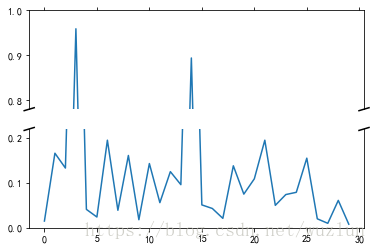
- from matplotlib.transforms import Affine2D
- import mpl_toolkits.axisartist.floating_axes as floating_axes
- import numpy as np
- import mpl_toolkits.axisartist.angle_helper as angle_helper
- from matplotlib.projections import PolarAxes
- from mpl_toolkits.axisartist.grid_finder import (FixedLocator, MaxNLocator,
- DictFormatter)
- import matplotlib.pyplot as plt
- # Fixing random state for reproducibility
- np.random.seed(19680801)
- def setup_axes1(fig, rect):
- """
- A simple one.
- """
- tr = Affine2D().scale(2, 1).rotate_deg(30)
- grid_helper = floating_axes.GridHelperCurveLinear(
- tr, extremes=(-0.5, 3.5, 0, 4))
- ax1 = floating_axes.FloatingSubplot(fig, rect, grid_helper=grid_helper)
- fig.add_subplot(ax1)
- aux_ax = ax1.get_aux_axes(tr)
- grid_helper.grid_finder.grid_locator1._nbins = 4
- grid_helper.grid_finder.grid_locator2._nbins = 4
- return ax1, aux_ax
- def setup_axes2(fig, rect):
- """
- With custom locator and formatter.
- Note that the extreme values are swapped.
- """
- tr = PolarAxes.PolarTransform()
- pi = np.pi
- angle_ticks = [(0, r"$0$"),
- (.25*pi, r"$\frac{1}{4}\pi$"),
- (.5*pi, r"$\frac{1}{2}\pi$")]
- grid_locator1 = FixedLocator([v for v, s in angle_ticks])
- tick_formatter1 = DictFormatter(dict(angle_ticks))
- grid_locator2 = MaxNLocator(2)
- grid_helper = floating_axes.GridHelperCurveLinear(
- tr, extremes=(.5*pi, 0, 2, 1),
- grid_locator1=grid_locator1,
- grid_locator2=grid_locator2,
- tick_formatter1=tick_formatter1,
- tick_formatter2=None)
- ax1 = floating_axes.FloatingSubplot(fig, rect, grid_helper=grid_helper)
- fig.add_subplot(ax1)
- # create a parasite axes whose transData in RA, cz
- aux_ax = ax1.get_aux_axes(tr)
- aux_ax.patch = ax1.patch # for aux_ax to have a clip path as in ax
- ax1.patch.zorder = 0.9 # but this has a side effect that the patch is
- # drawn twice, and possibly over some other
- # artists. So, we decrease the zorder a bit to
- # prevent this.
- return ax1, aux_ax
- def setup_axes3(fig, rect):
- """
- Sometimes, things like axis_direction need to be adjusted.
- """
- # rotate a bit for better orientation
- tr_rotate = Affine2D().translate(-95, 0)
- # scale degree to radians
- tr_scale = Affine2D().scale(np.pi/180., 1.)
- tr = tr_rotate + tr_scale + PolarAxes.PolarTransform()
- grid_locator1 = angle_helper.LocatorHMS(4)
- tick_formatter1 = angle_helper.FormatterHMS()
- grid_locator2 = MaxNLocator(3)
- # Specify theta limits in degrees
- ra0, ra1 = 8.*15, 14.*15
- # Specify radial limits
- cz0, cz1 = 0, 14000
- grid_helper = floating_axes.GridHelperCurveLinear(
- tr, extremes=(ra0, ra1, cz0, cz1),
- grid_locator1=grid_locator1,
- grid_locator2=grid_locator2,
- tick_formatter1=tick_formatter1,
- tick_formatter2=None)
- ax1 = floating_axes.FloatingSubplot(fig, rect, grid_helper=grid_helper)
- fig.add_subplot(ax1)
- # adjust axis
- ax1.axis["left"].set_axis_direction("bottom")
- ax1.axis["right"].set_axis_direction("top")
- ax1.axis["bottom"].set_visible(False)
- ax1.axis["top"].set_axis_direction("bottom")
- ax1.axis["top"].toggle(ticklabels=True, label=True)
- ax1.axis["top"].major_ticklabels.set_axis_direction("top")
- ax1.axis["top"].label.set_axis_direction("top")
- ax1.axis["left"].label.set_text(r"cz [km$^{-1}$]")
- ax1.axis["top"].label.set_text(r"$\alpha_{1950}$")
- # create a parasite axes whose transData in RA, cz
- aux_ax = ax1.get_aux_axes(tr)
- aux_ax.patch = ax1.patch # for aux_ax to have a clip path as in ax
- ax1.patch.zorder = 0.9 # but this has a side effect that the patch is
- # drawn twice, and possibly over some other
- # artists. So, we decrease the zorder a bit to
- # prevent this.
- return ax1, aux_ax
- fig = plt.figure(1, figsize=(8, 4))
- fig.subplots_adjust(wspace=0.3, left=0.05, right=0.95)
- ax1, aux_ax1 = setup_axes1(fig, 131)
- aux_ax1.bar([0, 1, 2, 3], [3, 2, 1, 3])
- ax2, aux_ax2 = setup_axes2(fig, 132)
- theta = np.random.rand(10)*.5*np.pi
- radius = np.random.rand(10) + 1.
- aux_ax2.scatter(theta, radius)
- ax3, aux_ax3 = setup_axes3(fig, 133)
- theta = (8 + np.random.rand(10)*(14 - 8))*15. # in degrees
- radius = np.random.rand(10)*14000.
- aux_ax3.scatter(theta, radius)
- plt.show()
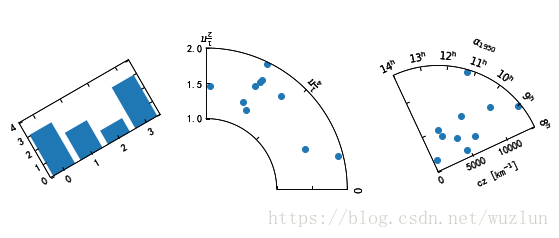
- import numpy as np
- import matplotlib.pyplot as plt
- import mpl_toolkits.axisartist.angle_helper as angle_helper
- from matplotlib.projections import PolarAxes
- from matplotlib.transforms import Affine2D
- from mpl_toolkits.axisartist import SubplotHost
- from mpl_toolkits.axisartist import GridHelperCurveLinear
- def curvelinear_test2(fig):
- """Polar projection, but in a rectangular box.
- """
- # see demo_curvelinear_grid.py for details
- tr = Affine2D().scale(np.pi / 180., 1.) + PolarAxes.PolarTransform()
- extreme_finder = angle_helper.ExtremeFinderCycle(20,
- 20,
- lon_cycle=360,
- lat_cycle=None,
- lon_minmax=None,
- lat_minmax=(0,
- np.inf),
- )
- grid_locator1 = angle_helper.LocatorDMS(12)
- tick_formatter1 = angle_helper.FormatterDMS()
- grid_helper = GridHelperCurveLinear(tr,
- extreme_finder=extreme_finder,
- grid_locator1=grid_locator1,
- tick_formatter1=tick_formatter1
- )
- ax1 = SubplotHost(fig, 1, 1, 1, grid_helper=grid_helper)
- fig.add_subplot(ax1)
- # Now creates floating axis
- # floating axis whose first coordinate (theta) is fixed at 60
- ax1.axis["lat"] = axis = ax1.new_floating_axis(0, 60)
- axis.label.set_text(r"$\theta = 60^{\circ}$")
- axis.label.set_visible(True)
- # floating axis whose second coordinate (r) is fixed at 6
- ax1.axis["lon"] = axis = ax1.new_floating_axis(1, 6)
- axis.label.set_text(r"$r = 6$")
- ax1.set_aspect(1.)
- ax1.set_xlim(-5, 12)
- ax1.set_ylim(-5, 10)
- ax1.grid(True)
- fig = plt.figure(1, figsize=(5, 5))
- fig.clf()
- curvelinear_test2(fig)
- plt.show()
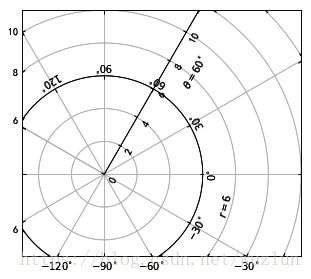
以上就是本文的全部内容,希望对大家的学习有所帮助,也希望大家多多支持服务器之家。
原文链接:https://blog.csdn.net/wuzlun/article/details/80053277










